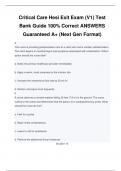Exam (elaborations)
Critical Care Hesi Exit Exam (V1) Test Bank Guide 100% Correct ANSWERS Guaranteed A+
- Course
- Institution
Critical Care Hesi Exit Exam (V1) Test Bank Guide 100% Correct ANSWERS Guaranteed A+ The nurse is providing postprocedure care to a client who had a cardiac catheterization. The client begins to manifest signs and symptoms associated with embolization. Which action should the nurse take? a. Notify ...
[Show more]



